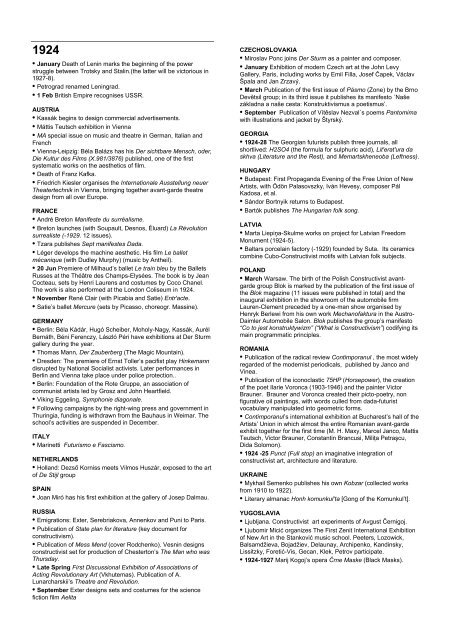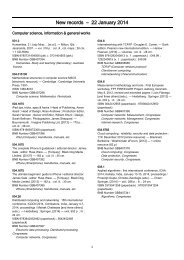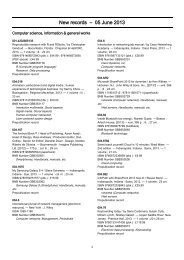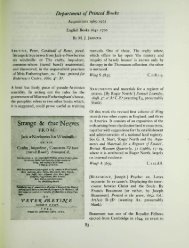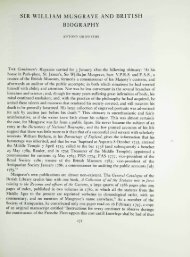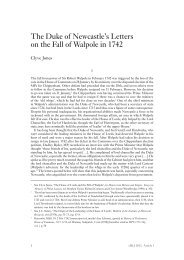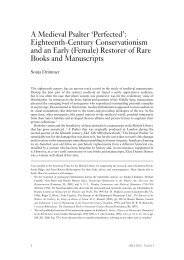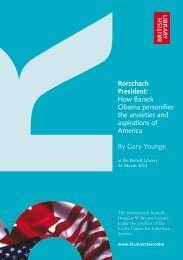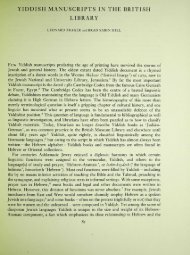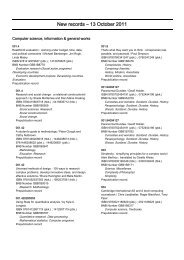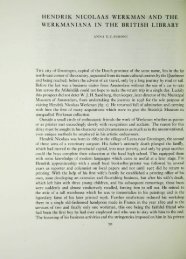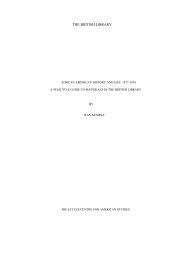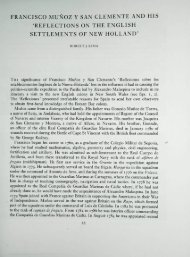Chronology of the European Avant Garde, 19001937 - British Library
Chronology of the European Avant Garde, 19001937 - British Library
Chronology of the European Avant Garde, 19001937 - British Library
Create successful ePaper yourself
Turn your PDF publications into a flip-book with our unique Google optimized e-Paper software.
1924<br />
• January Death <strong>of</strong> Lenin marks <strong>the</strong> beginning <strong>of</strong> <strong>the</strong> power<br />
struggle between Trotsky and Stalin.(<strong>the</strong> latter will be victorious in<br />
1927-8).<br />
• Petrograd renamed Leningrad.<br />
• 1 Feb <strong>British</strong> Empire recognises USSR.<br />
AUSTRIA<br />
• Kassák begins to design commercial advertisements.<br />
• Máttis Teutsch exhibition in Vienna<br />
• MA special issue on music and <strong>the</strong>atre in German, Italian and<br />
French<br />
• Vienna-Leipzig: Béla Balázs has his Der sichtbare Mensch, oder,<br />
Die Kultur des Films (X.981/3876) published, one <strong>of</strong> <strong>the</strong> first<br />
systematic works on <strong>the</strong> aes<strong>the</strong>tics <strong>of</strong> film.<br />
• Death <strong>of</strong> Franz Kafka.<br />
• Friedrich Kiesler organises <strong>the</strong> Internationale Ausstellung neuer<br />
Theatertechnik in Vienna, bringing toge<strong>the</strong>r avant-garde <strong>the</strong>atre<br />
design from all over Europe.<br />
FRANCE<br />
• André Breton Manifeste du surréalisme.<br />
• Breton launches (with Soupault, Desnos, Éluard) La Révolution<br />
surrealiste (-1929. 12 issues).<br />
• Tzara publishes Sept manifestes Dada.<br />
• Léger develops <strong>the</strong> machine aes<strong>the</strong>tic. His film Le ballet<br />
mécanique (with Dudley Murphy) (music by An<strong>the</strong>il).<br />
• 20 Jun Premiere <strong>of</strong> Milhaud’s ballet Le train bleu by <strong>the</strong> Ballets<br />
Russes at <strong>the</strong> Théâtre des Champs-Elysées. The book is by Jean<br />
Cocteau, sets by Henri Laurens and costumes by Coco Chanel.<br />
The work is also performed at <strong>the</strong> London Coliseum in 1924.<br />
• November René Clair (with Picabia and Satie) Entr'acte.<br />
• Satie’s ballet Mercure (sets by Picasso, choreogr. Massine).<br />
GERMANY<br />
• Berlin: Béla Kádár, Hugó Scheiber, Moholy-Nagy, Kassák, Aurél<br />
Bernáth, Béni Ferenczy, László Péri have exhibitions at Der Sturm<br />
gallery during <strong>the</strong> year.<br />
• Thomas Mann, Der Zauberberg (The Magic Mountain).<br />
• Dresden: The premiere <strong>of</strong> Ernst Toller’s pacifist play Hinkemann<br />
disrupted by National Socialist activists. Later performances in<br />
Berlin and Vienna take place under police protection..<br />
• Berlin: Foundation <strong>of</strong> <strong>the</strong> Rote Gruppe, an association <strong>of</strong><br />
communist artists led by Grosz and John Heartfield.<br />
• Viking Eggeling, Symphonie diagonale.<br />
• Following campaigns by <strong>the</strong> right-wing press and government in<br />
Thuringia, funding is withdrawn from <strong>the</strong> Bauhaus in Weimar. The<br />
school’s activities are suspended in December.<br />
ITALY<br />
• Marinetti Futurismo e Fascismo.<br />
NETHERLANDS<br />
• Holland: Dezső Korniss meets Vilmos Huszár, exposed to <strong>the</strong> art<br />
<strong>of</strong> De Stijl group<br />
SPAIN<br />
• Joan Miró has his first exhibition at <strong>the</strong> gallery <strong>of</strong> Josep Dalmau.<br />
RUSSIA<br />
• Emigrations: Exter, Serebriakova, Annenkov and Puni to Paris.<br />
• Publication <strong>of</strong> State plan for literature (key document for<br />
constructivism).<br />
• Publication <strong>of</strong> Mess Mend (cover Rodchenko). Vesnin designs<br />
constructivist set for production <strong>of</strong> Chesterton’s The Man who was<br />
Thursday.<br />
• Late Spring First Discussional Exhibition <strong>of</strong> Associations <strong>of</strong><br />
Acting Revolutionary Art (Vkhutemas). Publication <strong>of</strong> A.<br />
Lunarcharskii’s Theatre and Revolution.<br />
• September Exter designs sets and costumes for <strong>the</strong> science<br />
fiction film Aelita<br />
CZECHOSLOVAKIA<br />
• Miroslav Ponc joins Der Sturm as a painter and composer.<br />
• January Exhibition <strong>of</strong> modern Czech art at <strong>the</strong> John Levy<br />
Gallery, Paris, including works by Emil Filla, Josef Čapek, Václav<br />
Špala and Jan Zrzavý.<br />
• March Publication <strong>of</strong> <strong>the</strong> first issue <strong>of</strong> Pásmo (Zone) by <strong>the</strong> Brno<br />
Devětsil group; in its third issue it publishes its manifesto ´Naše<br />
základna a naše cesta: Konstruktivismus a poetismus’.<br />
• September Publication <strong>of</strong> Vítěslav Nezval´s poems Pantomima<br />
with illustrations and jacket by Štyrský.<br />
GEORGIA<br />
• 1924-28 The Georgian futurists publish three journals, all<br />
shortlived: H2SO4 (<strong>the</strong> formula for sulphuric acid), Lit'erat'ura da<br />
skhva (Literature and <strong>the</strong> Rest), and Memartskheneoba (Leftness).<br />
HUNGARY<br />
• Budapest: First Propaganda Evening <strong>of</strong> <strong>the</strong> Free Union <strong>of</strong> New<br />
Artists, with Ödön Palasovszky, Iván Hevesy, composer Pál<br />
Kadosa, et al.<br />
• Sándor Bortnyik returns to Budapest.<br />
• Bartók publishes The Hungarian folk song.<br />
LATVIA<br />
• Marta Liepiņa-Skulme works on project for Latvian Freedom<br />
Monument (1924-5).<br />
• Baltars porcelain factory (-1929) founded by Suta. Its ceramics<br />
combine Cubo-Constructivist motifs with Latvian folk subjects.<br />
POLAND<br />
• March Warsaw. The birth <strong>of</strong> <strong>the</strong> Polish Constructivist avantgarde<br />
group Blok is marked by <strong>the</strong> publication <strong>of</strong> <strong>the</strong> first issue <strong>of</strong><br />
<strong>the</strong> Blok magazine (11 issues were published in total) and <strong>the</strong><br />
inaugural exhibition in <strong>the</strong> showroom <strong>of</strong> <strong>the</strong> automobile firm<br />
Lauren-Clement preceded by a one-man show organised by<br />
Henryk Berlewi from his own work Mechan<strong>of</strong>aktura in <strong>the</strong> Austro-<br />
Daimler Automobile Salon. Blok publishes <strong>the</strong> group’s manifesto<br />
“Co to jest konstruktywizm” (“What is Constructivism”) codifying its<br />
main programmatic principles.<br />
ROMANIA<br />
• Publication <strong>of</strong> <strong>the</strong> radical review Contimporanul , <strong>the</strong> most widely<br />
regarded <strong>of</strong> <strong>the</strong> modernist periodicals, published by Janco and<br />
Vinea.<br />
• Publication <strong>of</strong> <strong>the</strong> iconoclastic 75HP (Horsepower), <strong>the</strong> creation<br />
<strong>of</strong> <strong>the</strong> poet Ilarie Voronca (1903-1946) and <strong>the</strong> painter Victor<br />
Brauner. Brauner and Voronca created <strong>the</strong>ir picto-poetry, non<br />
figurative oil paintings, with words culled from dada-futurist<br />
vocabulary manipulated into geometric forms.<br />
• Contimporanul’s international exhibition at Bucharest’s hall <strong>of</strong> <strong>the</strong><br />
Artists’ Union in which almost <strong>the</strong> entire Romanian avant-garde<br />
exhibit toge<strong>the</strong>r for <strong>the</strong> first time (M. H. Maxy, Marcel Janco, Mattis<br />
Teutsch, Victor Brauner, Constantin Brancusi, Miliţa Petraşcu,<br />
Dida Solomon).<br />
• 1924 -25 Punct (Full stop) an imaginative integration <strong>of</strong><br />
constructivist art, architecture and literature.<br />
UKRAINE<br />
• Mykhail Semenko publishes his own Kobzar (collected works<br />
from 1910 to 1922).<br />
• Literary almanac Honh komunkul’ta [Gong <strong>of</strong> <strong>the</strong> Komunkul’t].<br />
YUGOSLAVIA<br />
• Ljubljana. Constructivist art experiments <strong>of</strong> Avgust Černigoj.<br />
• Ljubomir Micić organizes The First Zenit International Exhibition<br />
<strong>of</strong> New Art in <strong>the</strong> Stanković music school. Peeters, Lozowick,<br />
Balsamdžieva, Bojadžiev, Delaunay, Archipenko, Kandinsky,<br />
Lissitzky, Foretić-Vis, Gecan, Klek, Petrov participate.<br />
• 1924-1927 Marij Kogoj’s opera Črne Maske (Black Masks).


